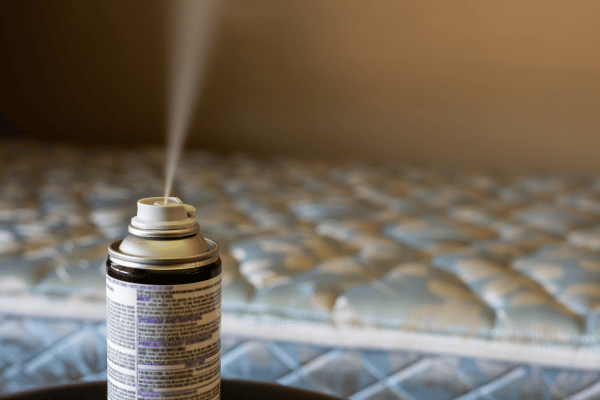- Home
- Silverfish Control
- Kill Silverfish
How To Kill Silverfish
This post may contain affiliate links so I earn a commission.
How to kill silverfish is probably a question and priority on your mind if you’ve noticed the silvery torpedo-shaped insect scurrying out of a bookcase or pantry.
Nobody wants their homes invaded by insects, and especially ones that cause damage to food products and sometimes, precious books or manuscripts.
Silverfish are creatures of the night and possibly the only time you might come across one in the daytime hours is if you happen to move objects they are hiding under.

If you move fast enough, you can kill silverfish by smashing them before they reach another hiding place.
You can usually bet that if you see one silverfish he has buddies waiting to come out and feast at night.
The insect is common in households throughout the U.S. and when summers are especially dry, those living in the wild will make their way indoors.
Silverfish make their way into your home on lumber products (especially green), wallboards and items of a similar nature.
Even concrete that is freshly laid can attract silverfish due to the humidity it produces.
Nocturnal Habits And Diet
When it’s dark, silverfish come out to drink water and feast; however, they can survive for several months without eating.

The insect’s main choice for food are those containing high amounts of starches, sugars or proteins, which include paper, including the glue and paste on papers and wallpaper, cereals, bindings of books, pasta, flour and even dog food.
The insects also use household dust, debris, various fungi and dead insects as a source of food.
Clothing that has starch in it is another target for silverfish and signs of the insect include yellowing stains and eaten fibers.
Silverfish Lifecycle
Female silverfish eggs are about 1/25th of an inch long and are laid on clothing, dusty areas, buried inside food or in crevices.
The average female lays anywhere from one to 200 eggs, with about 40 eggs average, so anyone would want to kill silverfish in their homes before they turn it into a baby-making nursery of silvery and scaly insects.
When conditions are warm and preferred, the eggs hatch in anywhere from several weeks to a month.

Colder conditions can delay the eggs from hatching for six weeks and as soon as the temperatures warm, the eggs begin hatching.
So, imagine how many offspring several female silverfish in your home produces within a year.
When temperatures dip to 50 degrees Fahrenheit and below, it can take silverfish 1.5 years to develop into an adult, but when temperatures are above 75 degrees Fahrenheit, the insect develops into its adult stage in as little as two months.
The insect lives for an average of three years and with all the eggs and newly developed ones, you will want to make “kill silverfish” your supreme goal and motto.
Managing Their Environment
The first step in ridding your home of the insect and not wondering if you’ll be spending years waging war to kill silverfish is making their environment less hospitable.
Since the insects travel long distances within the home to find their next meal, figuring out exactly where an infestation is can be difficult.
You can place sticky tape used for roaches along wall corners and edges where silverfish might be looking for their next meal to note how big of a problem you might have.
You can also make a simple trap by covering a small jar’s outside with masking tape.
The tape allows the silverfish to crawl up and fall inside, but the slippery nature of the inside of the glass doesn’t allow them to escape.

Keep areas that are prone to moisture like basements, laundry rooms and bathrooms dry and clean.
If areas of the home are dusty, remove the dust.
Repair any leaky pipes and holes around pipes leading into the home.
If you have piles of books, magazines or newspapers it’s best to shuffle them around frequently so the silverfish can’t take up residence underneath them.
You can also help control a problem by using dehumidifiers.
How To Kill Silverfish
If you’ve done everything to manage their environment, the next thing on your list is probably how to kill silverfish.
If the infestation is small, you most likely don’t have to do a thing to kill the little buggers other than removing sources of water and cleaning up areas inside the home.
You can kill the occasional silverfish in your home without the need of chemicals just by smashing it.
On the other hand and if the infestation is large, you will probably have to reach for the big guns to kill silverfish invading your home.
Check for household sprays containing the ingredients of pyrethrins and pyrethroids.
These ingredients will be listed on the label as bifenthrin, cyfluthrin, tetramethrin and phenothrin and kill the silverfish on contact.
Some of these products have residual action and continue to kill for days or sometimes weeks after the application.

You can use the sprays to cover the inside of cracks or crevices in walls or doors, around window casings, along baseboards, bookcases, in closets, along pipes, or any other area where silverfish frequent.
As always, read the label on application directions and warnings and don’t use near sources of water, food or food preparation areas, or where children or pets frequent.
Commercial dusts containing boric acid and synergized pyrethrins have been found effective when it comes to controlling silverfish if they are applied correctly.
Apply with a bulb duster to the same areas you would use an insecticidal spray.
Inorganic dust products like silica gel, diatomaceous earth and pyrethrins show good results when applied to areas that remain dry.
If the product becomes wet, you will have to reapply because when wet, it’s hard for the silverfish to pick it up on their body.
If you’ve cleaned the environment and made it hostile for the insects, and tried all the other methods to kill silverfish and they are still problematic, it’s probably time to call in the exterminator.



